2024届高三英语二轮专题特殊句式复习课件(共42张PPT)
文档属性
| 名称 | 2024届高三英语二轮专题特殊句式复习课件(共42张PPT) | 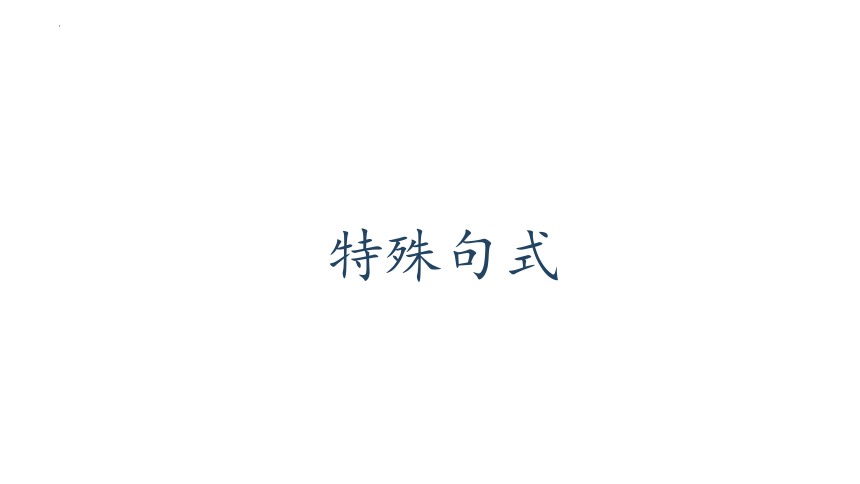 | |
| 格式 | pptx | ||
| 文件大小 | 172.5KB | ||
| 资源类型 | 教案 | ||
| 版本资源 | 通用版 | ||
| 科目 | 英语 | ||
| 更新时间 | 2024-03-09 20:53:31 | ||
图片预览

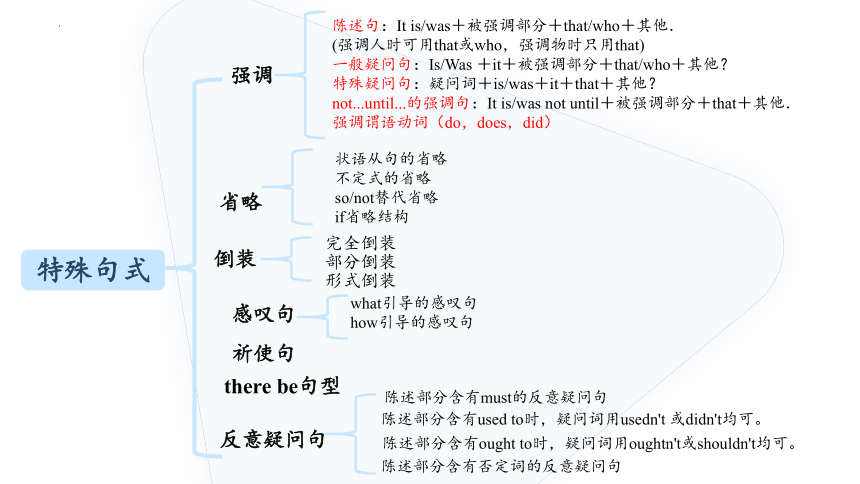
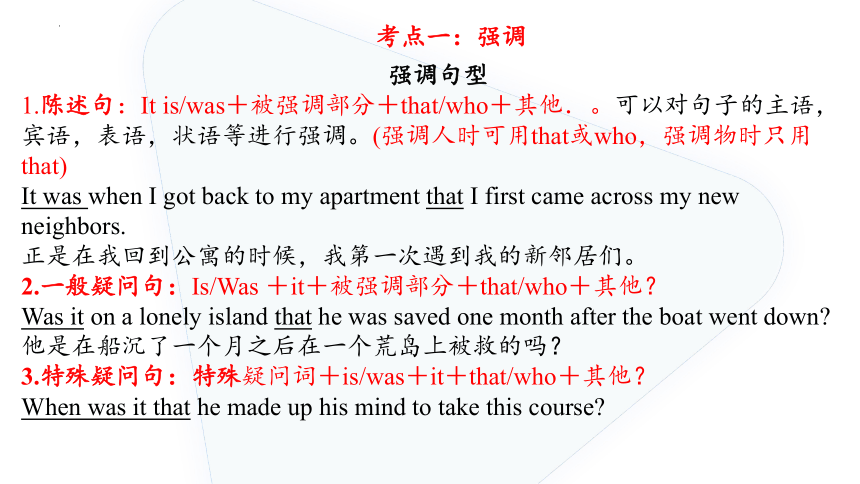
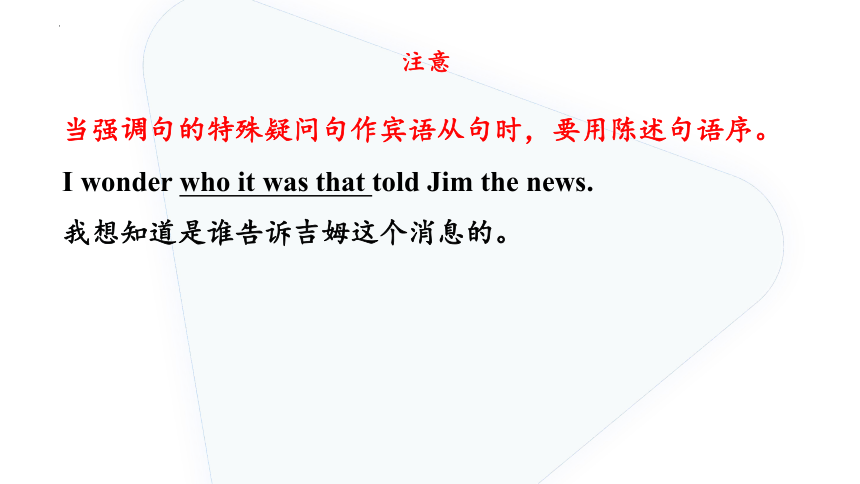
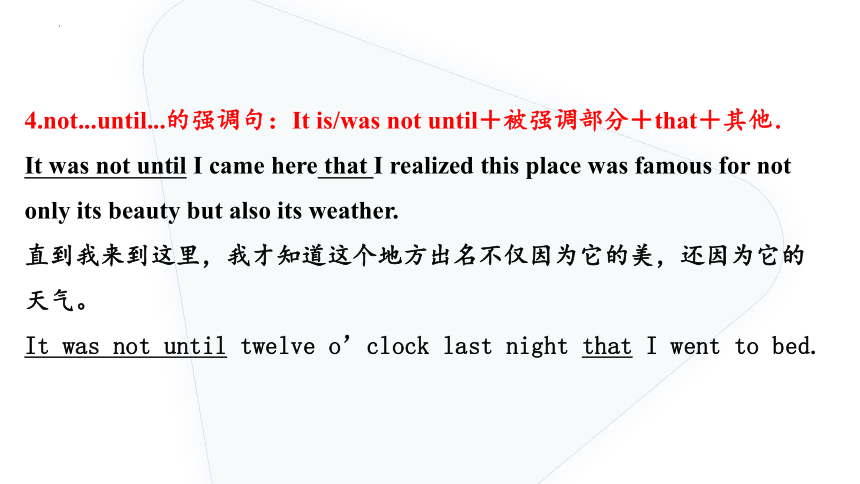
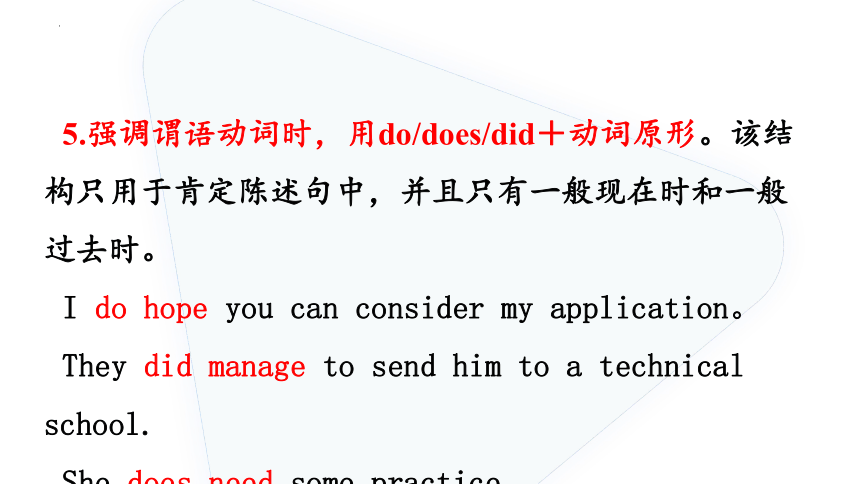


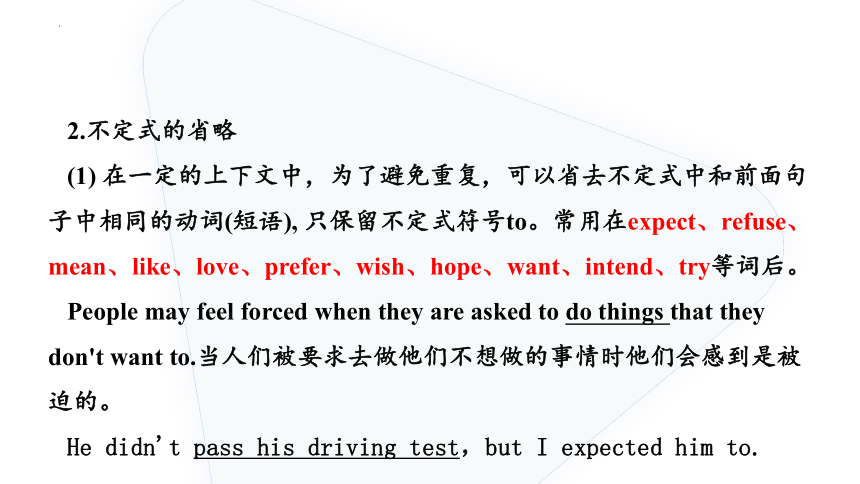
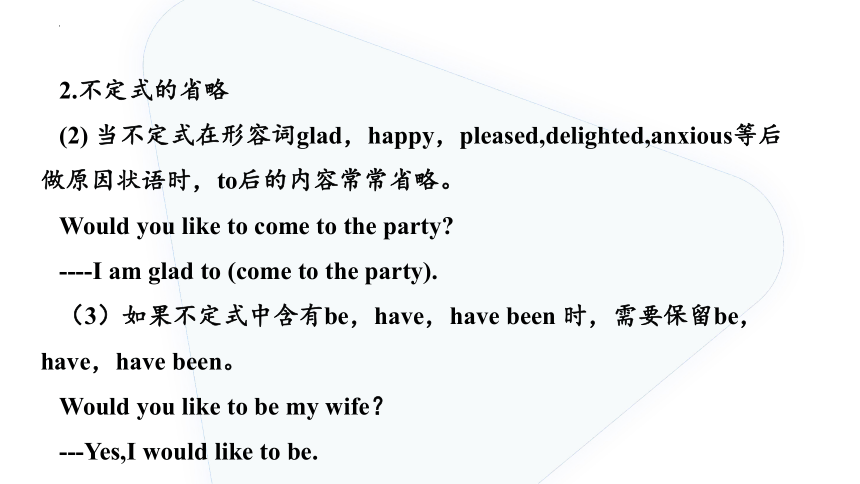
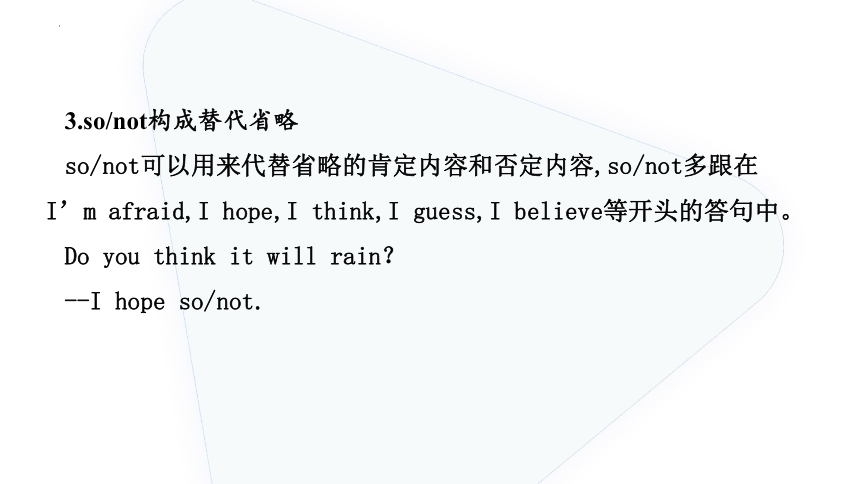
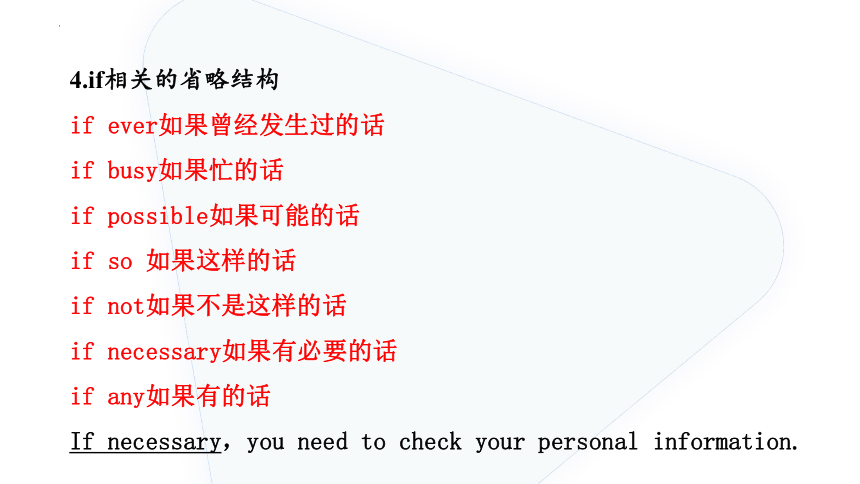
文档简介
(共42张PPT)
特殊句式
特殊句式
强调
倒装
省略
感叹句
祈使句
there be句型
反意疑问句
陈述句:It is/was+被强调部分+that/who+其他.
(强调人时可用that或who,强调物时只用that)
一般疑问句:Is/Was +it+被强调部分+that/who+其他?
特殊疑问句:疑问词+is/was+it+that+其他?
not...until...的强调句:It is/was not until+被强调部分+that+其他.
强调谓语动词(do,does,did)
完全倒装
部分倒装
形式倒装
状语从句的省略
不定式的省略
so/not替代省略
if省略结构
what引导的感叹句
how引导的感叹句
陈述部分含有must的反意疑问句
陈述部分含有used to时,疑问词用usedn't 或didn't均可。
陈述部分含有ought to时,疑问词用oughtn't或shouldn't均可。
陈述部分含有否定词的反意疑问句
强调句型
1.陈述句:It is/was+被强调部分+that/who+其他.。可以对句子的主语,宾语,表语,状语等进行强调。(强调人时可用that或who,强调物时只用that)
It was when I got back to my apartment that I first came across my new neighbors.
正是在我回到公寓的时候,我第一次遇到我的新邻居们。
2.一般疑问句:Is/Was +it+被强调部分+that/who+其他?
Was it on a lonely island that he was saved one month after the boat went down
他是在船沉了一个月之后在一个荒岛上被救的吗?
3.特殊疑问句:特殊疑问词+is/was+it+that/who+其他?
When was it that he made up his mind to take this course
考点一:强调
当强调句的特殊疑问句作宾语从句时,要用陈述句语序。
I wonder who it was that told Jim the news.
我想知道是谁告诉吉姆这个消息的。
注意
4.not...until...的强调句:It is/was not until+被强调部分+that+其他.
It was not until I came here that I realized this place was famous for not only its beauty but also its weather.
直到我来到这里,我才知道这个地方出名不仅因为它的美,还因为它的天气。
It was not until twelve o’clock last night that I went to bed.
5.强调谓语动词时,用do/does/did+动词原形。该结构只用于肯定陈述句中,并且只有一般现在时和一般过去时。
I do hope you can consider my application。
They did manage to send him to a technical school.
She does need some practice.
强调句型与三大从句的区别
1.强调句型与主语从句:去掉it is/was和that之后,句子完整就是强调句。而主语从句去掉之后,句子结构不完整。
It is there that accidents often happen.
It is a fact that English is being spoken by a lot of people.
2.强调句型与定语从句:强调句中的that没有意义且不做句子成份。定语从句中的that为关系代词,在句子中要做句子成分。
It is novels that Miss Wang enjoys reading.
It is a question that needs careful consideration.
3.强调句型与时间状语从句从句:去掉it is/was和that之后,句子完整就是强调句。而it is/was+时刻+when从句中,it指时间。
It was at 6:00 that I got up today.
It was 6:00 that I got up today.
It was 6:00 when I got up today.
1.状语从句的省略
在时间,条件,让步,方式,地点等状语从句中,如果状语从句的主语与主句的主语一致或从句主语是it,并且状语从句含有be时,可以将状语从句的主语连同be一起省掉。
1.While (I was )walking the dog on the street the other day,I met one of my old friends.
2.When (we are )faced with the situation,we should keep calm.
3.If (you are) asked to provide your information,inform the police at once.
4.If (it is) possible, he will help you out of difficulty.
考点二:省略
2.不定式的省略
(1) 在一定的上下文中,为了避免重复,可以省去不定式中和前面句子中相同的动词(短语), 只保留不定式符号to。常用在expect、refuse、mean、like、love、prefer、wish、hope、want、intend、try等词后。
People may feel forced when they are asked to do things that they don't want to.当人们被要求去做他们不想做的事情时他们会感到是被迫的。
He didn't pass his driving test,but I expected him to.
2.不定式的省略
(2) 当不定式在形容词glad,happy,pleased,delighted,anxious等后做原因状语时,to后的内容常常省略。
Would you like to come to the party
----I am glad to (come to the party).
(3)如果不定式中含有be,have,have been 时,需要保留be,have,have been。
Would you like to be my wife?
---Yes,I would like to be.
3.so/not构成替代省略
so/not可以用来代替省略的肯定内容和否定内容,so/not多跟在I’m afraid,I hope,I think,I guess,I believe等开头的答句中。
Do you think it will rain?
--I hope so/not.
4.if相关的省略结构
if ever如果曾经发生过的话
if busy如果忙的话
if possible如果可能的话
if so 如果这样的话
if not如果不是这样的话
if necessary如果有必要的话
if any如果有的话
If necessary,you need to check your personal information.
主语和谓语有两种顺序:主语在谓语前是自然顺序,谓语在主语前是倒装。
倒装的形式:
1.完全倒装
2.部分倒装
3.形式倒装
考点三 倒装
一.完全倒装:整个谓语部分放在主语的前面。
in,out,up,down,away,off,back,there,here,now,then,on the wall,in the room 等表示时间,地点,方位的副词或介词放在句首,且句子主语是名词时,句子要用完全倒装。
Out rushed the children.
There goes the bell.
Away she went.
There stands a temple(寺庙)on the top of the mountain.
Here are my suggestions.
2.有时为了平衡句子结构或强调,将做表语的介词短语、形容词、副词、分词结构提到句首,构成“表语+系动词+主语”的完全倒装结构。
Mr Green and other guests were present at the party.
Present at the party were Mr Green and other guests.
二.部分倒装:将谓语的一部分(助动词,情态动词,be)放到主语的前面,谓语的其他部分仍然放在主语的后面。
1.当“only +状语(从句)”放在句首时,句子(主句)要使用部分倒装。
I have received her letter only recently.
=Only recently have I received her letter.
We can live our dream life only by working hard.
=Only by working hard can we live our dream life.
I felt relieved only when he returned.
=Only when he returned did I feel relieved.
2.具有否定意义的连词,副词以及介词短语放在句首时,句子(主句)需要部分倒装。
not,never,seldom,rarely,little,few,hardly,barely,scarcely,nowhere,not until(直到….才),by no means(决不),in no way(决不),at no time(决不),on no condition(决不)under no circumstances(决不),not…..but…(不是…而是….),not only….but also…(前倒后不倒),no sooner …than,neither...nor...
I have never seen such an interesting book before.
=Never have I seen such an interesting book before.
I had hardly got home when it rained.
=Hardly had I got home when it rained.
I didn’t recognize him until he came close.
=Not until he came close did I recognise him.
3.so或such连同所修饰的的成分一起置于句首时,主句常用部分倒装。也就是把be/助动词/情态动词提到主语前。
It was such a lovely day that we all went swimming.
=Such a lovely day was it that we all went swimming.
今天天气如此的好,我们大家都去游泳了。
He is so selfish a boy that all people don't like him.
=So selfish a boy is he that all people don't like him.
He ran so fast that I couldn't catch up with him.
=So fast did he run that I couldn't catch up with him.
4. 表示前面所说的情况也适用于后者时使用部分倒装结构
So/Neither/Nor+be/情态动词/助动词+主语。(so表肯定,neither/nor表否定).so+主语+be/情态动词/助动词表示“确实如此”
I have never been abroad. Nor/Neither has he.
I saw the film yesterday. So did he.
He is not interested in math. So he is.
当前面两件事或两件以上的事也适合另一个人或物时,不用so/neither/nor结构,要用so it is with+sb或it is the same with sb结构
Tom likes singing,but he doesn’t like dancing. It is the same with Mary.
5.如果虚拟条件句中含有were,had,should,有时可以把if省略掉,把were,had,should提到主语前形成部分倒装,若为否定形式,not不可提前。
If she were my friend,I would ask her for help.
=Were she my friend,I would ask her for help.
If it had not been for the captain,the ship would have sunk.
=Had it not been for the captain,the ship would have sunk.
三.形式倒装:也称为前置。它的特点是,只需把强调的内容提到句首,主谓不倒装。
1.what/how感叹句
What a lovely girl she is.
How lovely the girl is.
2. The +比较级….the +比较级…..句型
The harder you work,the greater progress you will make.
3. whatever/however引导的让步状语从句。
Whatever reasons you have,you should carry out your promise.
However difficult the problem may be,we must work it out this evening.
4. as和though引导的让步状语从句,采用形式倒装的情况。
A: 表语的倒装(如果是单数名词或形容词的最高级作表语,前置要去掉冠词)
Tired as/though he was,he still went on his work.
Child as he is,he can carry the big box.
Youngest as he is in our class,he is the tallest.
B:动词的倒装
Try as he might,he didn’t pass the exam.
C:状语的倒装
Much as he likes the bike,he cannot afford it.
Hard as I studied,I couldn’t catch up with them.
引导让步状语从句的时候,as倒,although
不倒,though倒不倒都行
What a(n)+形容词+单数名词+主语+谓语! What an interesting story it is!
What a happy day it is!
What+形容词+复数名词/不可数名词+主语+谓语! What beautiful butterflies they are!
How+形容词+a(n)+单数名词+主语+谓语! How tall a boy he is!
How+形容词/副词+主语+谓语! How fast she ran!
How+主语+谓语! How times flies!
考点四 感叹句
What a strange plant it is(=How strange a plant it is)! I've never seen it before.
多么奇怪的一种植物啊!我以前从未见过。
The shocking news made me realize what terrible problems we would face.
这个惊人的消息使我意识到我们将面临多么严重的问题。
考点五 祈使句
祈使句常用来表示命令、请求、叮嘱、邀请、劝告、禁止、建议、警告等。祈使句的主语一般是第二人称you(常省略)。谓语动词用原形。祈使句的否定形式一般在动词原形前加don't, 也可用副词never构成。祈使句的强调形式可以在动词原形前加do。
Do your homework before you watch TV.
Don't forget to turn off the light.
Do be careful when you are crossing the road.
Lily,tidy your bedding up.
祈使句的常考形式
“祈使句+and+陈述句”表示“如果……就……” Do that again and I’ll call a policeman.
“祈使句+or+陈述句”表示“……否则……” Put it down,or I’ll smack you.
注意有时名词短语可以看作是祈使句。
A few more minutes and I will finish the work.
考点六 there be句型
(1)there be 句型中的be可以有不同的时态,可以和助动词或情态动词连用。并且be有时可用live、remain、stand、lie、exist、seem to be、appear to be、happen to be、used to be等替换。
There have been many great changes in our country since then. 从那时起我们国家发生了很多大的变化。
Once upon a time there lived an old fisherman in a village by the sea.
从前在海边的一个村庄里住着一位老渔夫。
(2)there be句型的常考句型:
①There is no point/sense (in) doing sth.做某事没有意义;
②There is no doubt that...毫无疑问……;
③There is no need (for sb.) to do sth.(某人)没有必要做某事;
④There is (no) difficulty/trouble in doing/with sth.做某事(没)有困难;
⑤There is no possibility of (doing) sth./that...(做)某事没有可能性。
考点七 反意疑问句
反意疑问句也叫附加疑问句。它表示提问人的看法,没有把握,需要对方证实。 反义疑问句由两部分组成:前一部分是一个陈述句(提出看法),后一部分是一个简短的疑问句/反问句(用来表示质疑或求证实),陈述句和疑问句部分的人称时态应保持一致。
主要形式:1.肯定陈述句+否定附加疑问句
2. 否定陈述句+肯定附加疑问句
You don’t like the music, do you (是吗?)
You like the music,don’t you?(不是吗?)
这类反意疑问句有时带有感彩,表示惊奇,愤怒,讽刺,不服气等。
You call this a day's work,don't you
你说这就叫一天的活儿,不是吗
陈述句中有助动词,情态动词,be的,疑问句中重复使用他们。陈述句中是实义动词,疑问句就借助助动词。疑问句人称和动词与陈述句的人称和动词保持一致。
You can’t swim,can you?
He is a teacher,isn’t he?
He likes money,doesn’t he?
He didn’t finish his homework,did he?
具体用法
1.陈述部分含有must的反意疑问句
(1)当must作“必须”讲时,反问句/疑问句用needn't;当为mustn't表示(不允许、禁止)时,反问句用must。
You must go now, needn't you 你现在必须走,不是吗?
You mustn't smoke here, must you 你不能在这里吸烟,是吧?
特殊用法
(2)当must表示推测,作“一定、准是”讲时,反问句的动词形式要根据must后面的动作所表示的时间来确定。
You must have watched the football match last night, didn't you?
你昨晚一定是看这场足球比赛了,是吧?
2.陈述部分含有used to时,反问句用usedn't 或didn't均可。
You used to play football, usedn't/didn't you
你过去常常踢足球,是吗?
3.陈述部分含有ought to时,反问句用oughtn't或shouldn't均可。
He ought to attend the meeting, oughtn't/shouldn't he
他应该参加会议,不是吗?
4.陈述部分含有否定词的反意疑问句
(1)当陈述部分含有seldom、hardly、scarcely、never、few、little、nothing、nobody 等否定词或半否定词时,反问句部分用肯定式。
He could hardly get up, could he
他几乎起不来了,不是吗?
(2)陈述部分含有表示否定意义的前缀或后缀构成的词时,反问句部分用否定式。
Mary dislikes sports, doesn't she
玛丽不喜欢体育运动,不是吗?
5.陈述部分含有宾语从句时,主句为二三人称时,反问句部分的主语和动词应和主句的主语动词保持一致。
She will come here on time,won't she?
He said that she would come here on time, didn't he
他说过她会准时来这里,不是吗?
当主句是 I think/believe/suppose...等结构时,(主句是一人称时)反问句部分的主语和动词要与宾语从句的主语和动词保持一致。需特别注意否定前移现象中的肯定式和否定式。一看从二三主
I think he will attend the meeting on time, won't he
I don't think he will attend the meeting on time, will he
我认为他不会准时参加会议,是吗?
在带宾语从句的复合句中,如果主句的谓语动词是think, believe, guess, feel, imagine等表示"观点、信念、推测"等心理活动的动词时,而且主句人称是一人称时,否定从句的not往往转移到主句,成为"形式否定主句,意义否定从句",这种语法现象就叫做否定前移。如:
I don't think he will come this afternoon.
我认为他今天下午不会来。
I don't believe he is a teacher.
我认为他不是老师。
I don't guess that they have got married.
我猜他们还没有结婚。.
I don't feel you should go.
我觉得你不应该去。
I didn't imagine that Tom would help her.
我猜想汤姆不会帮助她。
单句填空
1.In any unsafe situation,simply _______________(press) the button and a highly-trained agent will get you the help you need.
2.It was only when the car pulled up in front of our house _______________we saw Lily in the passenger seat.
3.It was when I got back to my apartment _______________I first came across my new neighbors.
4.Not until two years ago _______________they encourage the development of tourist-related activities in the rural areas.
5.You are waiting at a wrong place.It is at the hotel _______________the coach picks up tourists.
press
that
that
did
that
Ⅰ.单句语法填空
1._______________are three lessons in the morning and two in the afternoon.
2.It was not until midnight _______________they reached the camp site.
3.It doesn’t matter if they want to come to your birthday party,_______________it
4.We laugh at jokes,but seldom _________we think about how they work.
5.Only by keeping down costs _______________Power Data hold its advantage over other companies.
There
that
does
do
will/can/may
6.Mary never does any reading in the evening, _______________does John.
7.Give it a push,___________ an object will move forward.
8.Try _______________she might,Carolina couldn’t get the door open.
9.—I reminded you not to forget the appointment.
— _______________you did.
10.So much homework _______________we have to do that we had no time to take a rest.
nor/neither
and
though/as
So
did
1. It could be anything—gardening, cooking, music, sports—but whatever it is, _______ (make) sure it’s a relief from daily stress rather than another thing to worry about.
2. In any unsafe situation, simply_______ (press) the button and highly trained agent will get you the help you need.
3.It was only when the car pulled up in front of our house _______we saw Lily in the passenger seat.
4.Only then ____ we realize there was an earthquake. I was too frightened to move.
5.Not until two years ago_______ (do) they encourage the development of tourist-related activities in the rural areas.
6.______ unforgettable the experience was./_______ an unforgettable the experience.
make
press
that
did
did
How
What
特殊句式
特殊句式
强调
倒装
省略
感叹句
祈使句
there be句型
反意疑问句
陈述句:It is/was+被强调部分+that/who+其他.
(强调人时可用that或who,强调物时只用that)
一般疑问句:Is/Was +it+被强调部分+that/who+其他?
特殊疑问句:疑问词+is/was+it+that+其他?
not...until...的强调句:It is/was not until+被强调部分+that+其他.
强调谓语动词(do,does,did)
完全倒装
部分倒装
形式倒装
状语从句的省略
不定式的省略
so/not替代省略
if省略结构
what引导的感叹句
how引导的感叹句
陈述部分含有must的反意疑问句
陈述部分含有used to时,疑问词用usedn't 或didn't均可。
陈述部分含有ought to时,疑问词用oughtn't或shouldn't均可。
陈述部分含有否定词的反意疑问句
强调句型
1.陈述句:It is/was+被强调部分+that/who+其他.。可以对句子的主语,宾语,表语,状语等进行强调。(强调人时可用that或who,强调物时只用that)
It was when I got back to my apartment that I first came across my new neighbors.
正是在我回到公寓的时候,我第一次遇到我的新邻居们。
2.一般疑问句:Is/Was +it+被强调部分+that/who+其他?
Was it on a lonely island that he was saved one month after the boat went down
他是在船沉了一个月之后在一个荒岛上被救的吗?
3.特殊疑问句:特殊疑问词+is/was+it+that/who+其他?
When was it that he made up his mind to take this course
考点一:强调
当强调句的特殊疑问句作宾语从句时,要用陈述句语序。
I wonder who it was that told Jim the news.
我想知道是谁告诉吉姆这个消息的。
注意
4.not...until...的强调句:It is/was not until+被强调部分+that+其他.
It was not until I came here that I realized this place was famous for not only its beauty but also its weather.
直到我来到这里,我才知道这个地方出名不仅因为它的美,还因为它的天气。
It was not until twelve o’clock last night that I went to bed.
5.强调谓语动词时,用do/does/did+动词原形。该结构只用于肯定陈述句中,并且只有一般现在时和一般过去时。
I do hope you can consider my application。
They did manage to send him to a technical school.
She does need some practice.
强调句型与三大从句的区别
1.强调句型与主语从句:去掉it is/was和that之后,句子完整就是强调句。而主语从句去掉之后,句子结构不完整。
It is there that accidents often happen.
It is a fact that English is being spoken by a lot of people.
2.强调句型与定语从句:强调句中的that没有意义且不做句子成份。定语从句中的that为关系代词,在句子中要做句子成分。
It is novels that Miss Wang enjoys reading.
It is a question that needs careful consideration.
3.强调句型与时间状语从句从句:去掉it is/was和that之后,句子完整就是强调句。而it is/was+时刻+when从句中,it指时间。
It was at 6:00 that I got up today.
It was 6:00 that I got up today.
It was 6:00 when I got up today.
1.状语从句的省略
在时间,条件,让步,方式,地点等状语从句中,如果状语从句的主语与主句的主语一致或从句主语是it,并且状语从句含有be时,可以将状语从句的主语连同be一起省掉。
1.While (I was )walking the dog on the street the other day,I met one of my old friends.
2.When (we are )faced with the situation,we should keep calm.
3.If (you are) asked to provide your information,inform the police at once.
4.If (it is) possible, he will help you out of difficulty.
考点二:省略
2.不定式的省略
(1) 在一定的上下文中,为了避免重复,可以省去不定式中和前面句子中相同的动词(短语), 只保留不定式符号to。常用在expect、refuse、mean、like、love、prefer、wish、hope、want、intend、try等词后。
People may feel forced when they are asked to do things that they don't want to.当人们被要求去做他们不想做的事情时他们会感到是被迫的。
He didn't pass his driving test,but I expected him to.
2.不定式的省略
(2) 当不定式在形容词glad,happy,pleased,delighted,anxious等后做原因状语时,to后的内容常常省略。
Would you like to come to the party
----I am glad to (come to the party).
(3)如果不定式中含有be,have,have been 时,需要保留be,have,have been。
Would you like to be my wife?
---Yes,I would like to be.
3.so/not构成替代省略
so/not可以用来代替省略的肯定内容和否定内容,so/not多跟在I’m afraid,I hope,I think,I guess,I believe等开头的答句中。
Do you think it will rain?
--I hope so/not.
4.if相关的省略结构
if ever如果曾经发生过的话
if busy如果忙的话
if possible如果可能的话
if so 如果这样的话
if not如果不是这样的话
if necessary如果有必要的话
if any如果有的话
If necessary,you need to check your personal information.
主语和谓语有两种顺序:主语在谓语前是自然顺序,谓语在主语前是倒装。
倒装的形式:
1.完全倒装
2.部分倒装
3.形式倒装
考点三 倒装
一.完全倒装:整个谓语部分放在主语的前面。
in,out,up,down,away,off,back,there,here,now,then,on the wall,in the room 等表示时间,地点,方位的副词或介词放在句首,且句子主语是名词时,句子要用完全倒装。
Out rushed the children.
There goes the bell.
Away she went.
There stands a temple(寺庙)on the top of the mountain.
Here are my suggestions.
2.有时为了平衡句子结构或强调,将做表语的介词短语、形容词、副词、分词结构提到句首,构成“表语+系动词+主语”的完全倒装结构。
Mr Green and other guests were present at the party.
Present at the party were Mr Green and other guests.
二.部分倒装:将谓语的一部分(助动词,情态动词,be)放到主语的前面,谓语的其他部分仍然放在主语的后面。
1.当“only +状语(从句)”放在句首时,句子(主句)要使用部分倒装。
I have received her letter only recently.
=Only recently have I received her letter.
We can live our dream life only by working hard.
=Only by working hard can we live our dream life.
I felt relieved only when he returned.
=Only when he returned did I feel relieved.
2.具有否定意义的连词,副词以及介词短语放在句首时,句子(主句)需要部分倒装。
not,never,seldom,rarely,little,few,hardly,barely,scarcely,nowhere,not until(直到….才),by no means(决不),in no way(决不),at no time(决不),on no condition(决不)under no circumstances(决不),not…..but…(不是…而是….),not only….but also…(前倒后不倒),no sooner …than,neither...nor...
I have never seen such an interesting book before.
=Never have I seen such an interesting book before.
I had hardly got home when it rained.
=Hardly had I got home when it rained.
I didn’t recognize him until he came close.
=Not until he came close did I recognise him.
3.so或such连同所修饰的的成分一起置于句首时,主句常用部分倒装。也就是把be/助动词/情态动词提到主语前。
It was such a lovely day that we all went swimming.
=Such a lovely day was it that we all went swimming.
今天天气如此的好,我们大家都去游泳了。
He is so selfish a boy that all people don't like him.
=So selfish a boy is he that all people don't like him.
He ran so fast that I couldn't catch up with him.
=So fast did he run that I couldn't catch up with him.
4. 表示前面所说的情况也适用于后者时使用部分倒装结构
So/Neither/Nor+be/情态动词/助动词+主语。(so表肯定,neither/nor表否定).so+主语+be/情态动词/助动词表示“确实如此”
I have never been abroad. Nor/Neither has he.
I saw the film yesterday. So did he.
He is not interested in math. So he is.
当前面两件事或两件以上的事也适合另一个人或物时,不用so/neither/nor结构,要用so it is with+sb或it is the same with sb结构
Tom likes singing,but he doesn’t like dancing. It is the same with Mary.
5.如果虚拟条件句中含有were,had,should,有时可以把if省略掉,把were,had,should提到主语前形成部分倒装,若为否定形式,not不可提前。
If she were my friend,I would ask her for help.
=Were she my friend,I would ask her for help.
If it had not been for the captain,the ship would have sunk.
=Had it not been for the captain,the ship would have sunk.
三.形式倒装:也称为前置。它的特点是,只需把强调的内容提到句首,主谓不倒装。
1.what/how感叹句
What a lovely girl she is.
How lovely the girl is.
2. The +比较级….the +比较级…..句型
The harder you work,the greater progress you will make.
3. whatever/however引导的让步状语从句。
Whatever reasons you have,you should carry out your promise.
However difficult the problem may be,we must work it out this evening.
4. as和though引导的让步状语从句,采用形式倒装的情况。
A: 表语的倒装(如果是单数名词或形容词的最高级作表语,前置要去掉冠词)
Tired as/though he was,he still went on his work.
Child as he is,he can carry the big box.
Youngest as he is in our class,he is the tallest.
B:动词的倒装
Try as he might,he didn’t pass the exam.
C:状语的倒装
Much as he likes the bike,he cannot afford it.
Hard as I studied,I couldn’t catch up with them.
引导让步状语从句的时候,as倒,although
不倒,though倒不倒都行
What a(n)+形容词+单数名词+主语+谓语! What an interesting story it is!
What a happy day it is!
What+形容词+复数名词/不可数名词+主语+谓语! What beautiful butterflies they are!
How+形容词+a(n)+单数名词+主语+谓语! How tall a boy he is!
How+形容词/副词+主语+谓语! How fast she ran!
How+主语+谓语! How times flies!
考点四 感叹句
What a strange plant it is(=How strange a plant it is)! I've never seen it before.
多么奇怪的一种植物啊!我以前从未见过。
The shocking news made me realize what terrible problems we would face.
这个惊人的消息使我意识到我们将面临多么严重的问题。
考点五 祈使句
祈使句常用来表示命令、请求、叮嘱、邀请、劝告、禁止、建议、警告等。祈使句的主语一般是第二人称you(常省略)。谓语动词用原形。祈使句的否定形式一般在动词原形前加don't, 也可用副词never构成。祈使句的强调形式可以在动词原形前加do。
Do your homework before you watch TV.
Don't forget to turn off the light.
Do be careful when you are crossing the road.
Lily,tidy your bedding up.
祈使句的常考形式
“祈使句+and+陈述句”表示“如果……就……” Do that again and I’ll call a policeman.
“祈使句+or+陈述句”表示“……否则……” Put it down,or I’ll smack you.
注意有时名词短语可以看作是祈使句。
A few more minutes and I will finish the work.
考点六 there be句型
(1)there be 句型中的be可以有不同的时态,可以和助动词或情态动词连用。并且be有时可用live、remain、stand、lie、exist、seem to be、appear to be、happen to be、used to be等替换。
There have been many great changes in our country since then. 从那时起我们国家发生了很多大的变化。
Once upon a time there lived an old fisherman in a village by the sea.
从前在海边的一个村庄里住着一位老渔夫。
(2)there be句型的常考句型:
①There is no point/sense (in) doing sth.做某事没有意义;
②There is no doubt that...毫无疑问……;
③There is no need (for sb.) to do sth.(某人)没有必要做某事;
④There is (no) difficulty/trouble in doing/with sth.做某事(没)有困难;
⑤There is no possibility of (doing) sth./that...(做)某事没有可能性。
考点七 反意疑问句
反意疑问句也叫附加疑问句。它表示提问人的看法,没有把握,需要对方证实。 反义疑问句由两部分组成:前一部分是一个陈述句(提出看法),后一部分是一个简短的疑问句/反问句(用来表示质疑或求证实),陈述句和疑问句部分的人称时态应保持一致。
主要形式:1.肯定陈述句+否定附加疑问句
2. 否定陈述句+肯定附加疑问句
You don’t like the music, do you (是吗?)
You like the music,don’t you?(不是吗?)
这类反意疑问句有时带有感彩,表示惊奇,愤怒,讽刺,不服气等。
You call this a day's work,don't you
你说这就叫一天的活儿,不是吗
陈述句中有助动词,情态动词,be的,疑问句中重复使用他们。陈述句中是实义动词,疑问句就借助助动词。疑问句人称和动词与陈述句的人称和动词保持一致。
You can’t swim,can you?
He is a teacher,isn’t he?
He likes money,doesn’t he?
He didn’t finish his homework,did he?
具体用法
1.陈述部分含有must的反意疑问句
(1)当must作“必须”讲时,反问句/疑问句用needn't;当为mustn't表示(不允许、禁止)时,反问句用must。
You must go now, needn't you 你现在必须走,不是吗?
You mustn't smoke here, must you 你不能在这里吸烟,是吧?
特殊用法
(2)当must表示推测,作“一定、准是”讲时,反问句的动词形式要根据must后面的动作所表示的时间来确定。
You must have watched the football match last night, didn't you?
你昨晚一定是看这场足球比赛了,是吧?
2.陈述部分含有used to时,反问句用usedn't 或didn't均可。
You used to play football, usedn't/didn't you
你过去常常踢足球,是吗?
3.陈述部分含有ought to时,反问句用oughtn't或shouldn't均可。
He ought to attend the meeting, oughtn't/shouldn't he
他应该参加会议,不是吗?
4.陈述部分含有否定词的反意疑问句
(1)当陈述部分含有seldom、hardly、scarcely、never、few、little、nothing、nobody 等否定词或半否定词时,反问句部分用肯定式。
He could hardly get up, could he
他几乎起不来了,不是吗?
(2)陈述部分含有表示否定意义的前缀或后缀构成的词时,反问句部分用否定式。
Mary dislikes sports, doesn't she
玛丽不喜欢体育运动,不是吗?
5.陈述部分含有宾语从句时,主句为二三人称时,反问句部分的主语和动词应和主句的主语动词保持一致。
She will come here on time,won't she?
He said that she would come here on time, didn't he
他说过她会准时来这里,不是吗?
当主句是 I think/believe/suppose...等结构时,(主句是一人称时)反问句部分的主语和动词要与宾语从句的主语和动词保持一致。需特别注意否定前移现象中的肯定式和否定式。一看从二三主
I think he will attend the meeting on time, won't he
I don't think he will attend the meeting on time, will he
我认为他不会准时参加会议,是吗?
在带宾语从句的复合句中,如果主句的谓语动词是think, believe, guess, feel, imagine等表示"观点、信念、推测"等心理活动的动词时,而且主句人称是一人称时,否定从句的not往往转移到主句,成为"形式否定主句,意义否定从句",这种语法现象就叫做否定前移。如:
I don't think he will come this afternoon.
我认为他今天下午不会来。
I don't believe he is a teacher.
我认为他不是老师。
I don't guess that they have got married.
我猜他们还没有结婚。.
I don't feel you should go.
我觉得你不应该去。
I didn't imagine that Tom would help her.
我猜想汤姆不会帮助她。
单句填空
1.In any unsafe situation,simply _______________(press) the button and a highly-trained agent will get you the help you need.
2.It was only when the car pulled up in front of our house _______________we saw Lily in the passenger seat.
3.It was when I got back to my apartment _______________I first came across my new neighbors.
4.Not until two years ago _______________they encourage the development of tourist-related activities in the rural areas.
5.You are waiting at a wrong place.It is at the hotel _______________the coach picks up tourists.
press
that
that
did
that
Ⅰ.单句语法填空
1._______________are three lessons in the morning and two in the afternoon.
2.It was not until midnight _______________they reached the camp site.
3.It doesn’t matter if they want to come to your birthday party,_______________it
4.We laugh at jokes,but seldom _________we think about how they work.
5.Only by keeping down costs _______________Power Data hold its advantage over other companies.
There
that
does
do
will/can/may
6.Mary never does any reading in the evening, _______________does John.
7.Give it a push,___________ an object will move forward.
8.Try _______________she might,Carolina couldn’t get the door open.
9.—I reminded you not to forget the appointment.
— _______________you did.
10.So much homework _______________we have to do that we had no time to take a rest.
nor/neither
and
though/as
So
did
1. It could be anything—gardening, cooking, music, sports—but whatever it is, _______ (make) sure it’s a relief from daily stress rather than another thing to worry about.
2. In any unsafe situation, simply_______ (press) the button and highly trained agent will get you the help you need.
3.It was only when the car pulled up in front of our house _______we saw Lily in the passenger seat.
4.Only then ____ we realize there was an earthquake. I was too frightened to move.
5.Not until two years ago_______ (do) they encourage the development of tourist-related activities in the rural areas.
6.______ unforgettable the experience was./_______ an unforgettable the experience.
make
press
that
did
did
How
What
